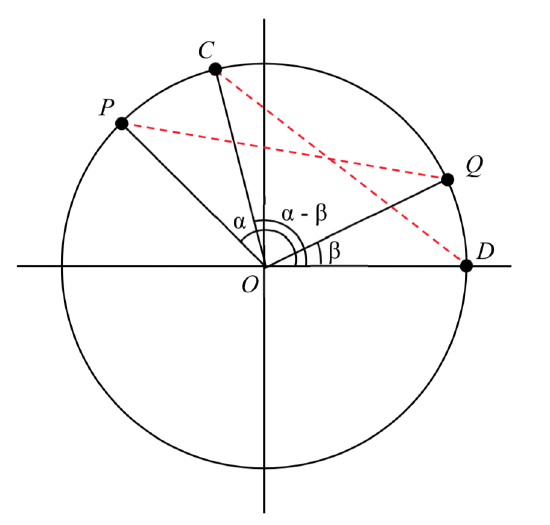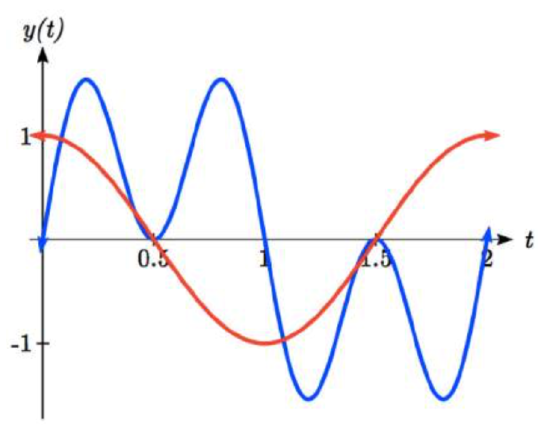7.2: Addition and Subtraction Identities
( \newcommand{\kernel}{\mathrm{null}\,}\)
Section 7.2 Addition and Subtraction Identities
In this section, we begin expanding our repertoire of trigonometric identities.
The sum and difference identities
cos(α−β)=cos(α)cos(β)+sin(α)sin(β)
cos(α+β)=cos(α)cos(β)−sin(α)sin(β)
sin(α+β)=sin(α)cos(β)+cos(α)sin(β)
sin(α−β)=sin(α)cos(β)−cos(α)sin(β)
We will prove the difference of angles identity for cosine. The rest of the identities can be derived from this one.
Proof of the difference of angles identity for cosine
Consider two points on a unit circle:
P at an angle of α from the positive x axis with coordinates (cos(α),sin(α)), and Q at an angle of β with coordinates (cos(β),sin(β)).
Notice the measure of angle POQ is α – β. Label two more points:
C at an angle of α – β, with coordinates (cos(α−β),sin(α−β)),
D at the point (1, 0).
Notice that the distance from C to D is the same as the distance from P to Q because triangle COD is a rotation of triangle POQ.
Using the distance formula to find the distance from P to Q yields
√(cos(α)−cos(β))2+(sin(α)−sin(β))2
Expanding this
√cos2(α)−2cos(α)cos(β)+cos2(β)+sin2(α)−2sin(α)sin(β)+sin2(β)
Applying the Pythagorean Identity and simplifying
√2−2cos(α)cos(β)−2sin(α)sin(β)
Similarly, using the distance formula to find the distance from C to D
√(cos(α−β)−1)2+(sin(α−β)−0)2
Expanding this
√cos2(α−β)−2cos(α−β)+1+sin2(α−β)
Applying the Pythagorean Identity and simplifying
√−2cos(α−β)+2
Since the two distances are the same we set these two formulas equal to each other and simplify
√2−2cos(α)cos(β)−2sin(α)sin(β)=√−2cos(α−β)+2
2−2cos(α)cos(β)−2sin(α)sin(β)=−2cos(α−β)+2
cos(α)cos(β)+sin(α)sin(β)=cos(α−β)
This establishes the identity.
Exercise 7.2.1
By writing cos(α+β) as cos(α−(−β)), show the sum of angles identity for cosine follows from the difference of angles identity proven above.
- Answer
-
cos(α+β)=cos(α−(−β))cos(α)cos(−β)+sin(α)sin(−β)cos(α)cos(β)+sin(α)(−sin(β))cos(α)cos(β)−sin(α)sin(β)
The sum and difference of angles identities are often used to rewrite expressions in other forms, or to rewrite an angle in terms of simpler angles.
Example 7.2.1
Find the exact value of cos(75∘).
Solution
Since 75∘=30∘+45∘, we can evaluate cos(75∘) as
cos(75∘)=cos(30∘+45∘) Apply the cosine sum of angles identity
=cos(30∘)cos(45∘)−sin(30∘)sin(45∘) Evaluate
=√32⋅√22−12⋅√22 Simply
=√6−√24
Exercise 7.2.2
Find the exact value of sin(π12).
- Answer
-
sin(π12)=sin(π3−π4)=sin(π3)cos(π4)−cos(π3)sin(π4)
=√32√22−12√22√6−√24
Example 7.2.2
Rewrite sin(x−π4) in terms of sin(x) and cos(x).
Solution
sin(x−π4)Use the difference of angles identity for sine
=sin(x)cos(π4)−cos(x)sin(π4) Evaluate the cosine and sine and rearrange
=√22sin(x)−√22cos(x)
Additionally, these identities can be used to simplify expressions or prove new identities
Example 7.2.3
Prove sin(a+b)sin(a−b)=tan(a)+tan(b)tan(a)−tan(b).
Solution
As with any identity, we need to first decide which side to begin with. Since the left side involves sum and difference of angles, we might start there
sin(a+b)sin(a−b) Apply the sum and difference of angle identities
=sin(a)cos(b)+cos(a)sin(b)sin(a)cos(b)−cos(a)sin(b)
Since it is not immediately obvious how to proceed, we might start on the other side, and see if the path is more apparent.
tan(a)+tan(b)tan(a)−tan(b) Rewriting the tangents using the tangent identity
=sin(a)cos(a)+sin(b)cos(b)sin(a)cos(a)−sin(b)cos(b)Multiplying the top and bottom by cos(a)cos(b)
=(sin(a)cos(a)+sin(b)cos(b))cos(a)cos(b)(sin(a)cos(a)−sin(b)cos(b))cos(a)cos(b)Distributing and simplifying
=sin(a)cos(b)+sin(b)cos(a)sin(a)cos(b)−sin(b)cos(a)From above, we recognize this
=sin(a+b)sin(a−b)Establishing the identity
These identities can also be used to solve equations.
Example 7.2.4
Solve sin(x)sin(2x)+cos(x)cos(2x)=√32.
Solution
By recognizing the left side of the equation as the result of the difference of angles identity for cosine, we can simplify the equation
sin(x)sin(2x)+cos(x)cos(2x)=√32Apply the difference of angles identity
cos(x−2x)=√32
cos(−x)=√32Use the negative angle identity
cos(x)=√32
Since this is a special cosine value we recognize from the unit circle, we can quickly write the answers:
x=π6+2πkx=11π6+2πk, where k is an integer
Combining Waves of Equal Period
A sinusoidal function of the form f(x)=Asin(Bx+C) can be rewritten using the sum of angles identity.
Example 7.2.5
Rewrite f(x)=4sin(3x+π3) as a sum of sine and cosine.
Solution
4sin(3x+π3)Using the sum of angles identity
=4(sin(3x)cos(π3)+cos(3x)sin(π3))Evaluate the sine and cosine
=4(sin(3x)⋅12+cos(3x)⋅√32)Distribute and simplify
=2sin(3x)+2√3cos(3x)
Notice that the result is a stretch of the sine added to a different stretch of the cosine, but both have the same horizontal compression, which results in the same period.
We might ask now whether this process can be reversed – can a combination of a sine and cosine of the same period be written as a single sinusoidal function? To explore this, we will look in general at the procedure used in the example above.
f(x)=Asin(Bx+C)Use the sum of angles identity
=A(sin(Bx)cos(C)+cos(Bx)sin(C))Distribute the A
=Asin(Bx)cos(C)+Acos(Bx)sin(C)Rearrange the terms a bit
=Acos(C)sin(Bx)+Asin(C)cos(Bx)
Based on this result, if we have an expression of the form msin(Bx)+ncos(Bx), we could rewrite it as a single sinusoidal function if we can find values A and C so that
msin(Bx)+ncos(Bx) =Acos(C)sin(Bx)+Asin(C)cos(Bx), which will require that:
m=Acos(C)n=Asin(C) which can be rewritten as mA=cos(C)nA=sin(C)
To find A,
m2+n2=(Acos(C))2+(Asin(C))2
=A2cos2(C)+A2sin2(C)
=A2(cos2(C)+sin2(C))Apply the Pythagorean Identity and simplify
=A2
REWRITING A SUM OF SINE AND COSINE AS A SINGLE SINE
To rewrite msin(Bx)+ncos(Bx) as Asin(Bx+C)
A2=m2+n2cos(C)=mA and sin(C)=nA
You can use either of the last two equations to solve for possible values of C. Since there will usually be two possible solutions, we will need to look at both to determine which quadrant C is in and determine which solution for C satisfies both equations.
Example 7.2.6
Rewrite 4√3sin(2x)−4cos(2x) as a single sinusoidal function.
Solution
Using the formulas above, A2=(4√3)2+(−4)2=16⋅3+16=64, so A=8.
Solving for C,
cos(C)=4√38=√32 so C=π6 or C=11π6
However, notice sin(C)=−48=−12. Sine is negative in the third and fourth quadrant, so the angle that works for both is C=11π6.
Combining these results gives us the expression
8sin(2x+11π6)
Exercise 7.2.3
Rewrite −3√2sin(5x)+3√2cos(5x) as a single sinusoidal function.
- Answer
-
A2=(−3√2)2+(3√2)2=36A=6
cos(C)=−3√26=−√22sin(C)=3√26=√22C=3π4
6sin(5x+3π4)
Rewriting a combination of sine and cosine of equal periods as a single sinusoidal function provides an approach for solving some equations.
Example 7.2.7
Solve 3sin(2x)+4cos(2x)=1 to find two positive solutions.
Solution
Since the sine and cosine have the same period, we can rewrite them as a single sinusoidal function.
A2=(3)2+(4)2=25 so A=5
cos(C)=35 so C=cos−1(35)≈0.927 or C=2π−0.927=5.356
Since sin(C)=45, a positive value, we need the angle in the first quadrant, C=0.927.
Using this, our equation becomes
5sin(2x+0.927)=1 Divide by 5
sin(2x+0.927)=15 Make the substitution u=2x+0.927
sin(u)=15The inverse gives a first solution
u=sin−1(15)≈0.201 By symmetry, the second solution is
u=π−0.201=2.940 A third solution would be
u=2π+0.201=6.485
Undoing the substitution, we can find two positive solutions for x.
2x+0.927=0.201or2x+0.927=2.940or2x+0.927=6.4852x=−0.7262x=2.0132x=5.558x=−0.363x=1.007x=2.779
Since the first of these is negative, we eliminate it and keep the two positive solutions, x=1.007 and x=2.779.
The Product-to-Sum and Sum-to-Product Identities
The Product-to-Sum Identities
sin(α)cos(β)=12(sin(α+β)+sin(α−β))sin(α)sin(β)=12(cos(α−β)−cos(α+β))cos(α)cos(β)=12(cos(α+β)+cos(α−β))
We will prove the first of these, using the sum and difference of angles identities from the beginning of the section. The proofs of the other two identities are similar and are left as an exercise.
Proof of the product-to-sum identity for sin(α)cos(β)
Recall the sum and difference of angles identities from earlier
sin(α+β)=sin(α)cos(β)+cos(α)sin(β)
sin(α−β)=sin(α)cos(β)−cos(α)sin(β)
Adding these two equations, we obtain
sin(α+β)+sin(α−β)=2sin(α)cos(β)
Dividing by 2, we establish the identity
sin(α)cos(β)=12(sin(α+β)+sin(α−β))
Example 7.2.8
Write sin(2t)sin(4t) as a sum or difference.
Solution
Using the product-to-sum identity for a product of sines
sin(2t)sin(4t)=12(cos(2t−4t)−cos(2t+4t))
=12(cos(−2t)−cos(6t))If desired, apply the negative angle identity
=12(cos(2t)−cos(6t))Distribute
=12cos(2t)−12cos(6t)
Exercise 7.2.4
Evaluate cos(11π12)cos(π12).
- Answer
-
cos(11π12)cos(π12)=12(cos(11π12+π12)+cos(11π12−π12))
=12(cos(π)+cos(5π6))=12(−1−√32)
=−2−√34
The Sum-to-Product Identities
sin(u)+sin(v)=2sin(u+v2)cos(u−v2)
sin(u)−sin(v)=2sin(u−v2)cos(u+v2)
cos(u)+cos(v)=2cos(u+v2)cos(u−v2)
cos(u)−cos(v)=−2sin(u+v2)sin(u−v2)
We will again prove one of these and leave the rest as an exercise.
Proof of the sum-to-product identity for sine function
We define two new variables:
u=α+βv=α−β
Adding these equations yields u+v=2α, giving α=u+v2
Subtracting the equations yields u−v=2β, or β=u−v2
Substituting these expressions into the product-to-sum identity
sin(α)cos(β)=12(sin(α+β)+sin(α−β))gives
sin(u+v2)cos(u−v2)=12(sin(u)+sin(v))Multiply by 2 on both sides
2sin(u+v2)cos(u−v2)=sin(u)+sin(v)Establishing the identity
Exercise 7.2.5
Notice that, using the negative angle identity, sin(u)−sin(v)=sin(u)+sin(−v). Use this along with the sum of sines identity to prove the sum-to-product identity for sin(u)−sin(v).
- Answer
-
sin(u)−sin(v)Use negative angle identity for sine
sin(u)+sin(−v)Use sum-to-product identity for sine
2sin(u+(−v)2)cos(u−(−v)2)Eliminate the parenthesis
2sin(u−v2)cos(u+v2)Establishing the identity
Example 7.2.9
Evaluate cos(15∘)−cos(75∘).
Solution
Using the sum-to-product identity for the difference of cosines,
cos(15∘)−cos(75∘)
=−2sin(15∘+75∘2)sin(15∘−75∘2)Simplify
=−2sin(45∘)sin(−30∘)Evaluate
=−2⋅√22⋅−12=√22
Example 7.2.10
Prove the identity cos(4t)−cos(2t)sin(4t)+sin(2t)=−tan(t).
Solution
Since the left side seems more complicated, we can start there and simplify.
cos(4t)−cos(2t)sin(4t)+sin(2t)Use the sum-to-product identities
=−2sin(4t+2t2)sin(4t−2t2)2sin(4t+2t2)cos(4t−2t2)Simplify
=−2sin(3t)sin(t)2sin(3t)cos(t)Simplify further
=−sin(t)cos(t)Rewrite as a tangent
=−tan(t)Establishing the identity
Example 7.2.11
Solve sin(πt)+sin(3πt)=cos(πt) for all solutions with 0≤t<2.
Solution
In an equation like th is, it is not immediately obvious how to proceed. One option would be to combine the two sine functions on the left side of the equation. Another would be to move the cosine to the left side of the equation, and combine it with one of the sines. For no particularly good reason, we’ll begin by combining the sines on the left side of the equation and see how things work out.
sin(πt)+sin(3πt)=cos(πt)Apply the sum to product identity on the left
2sin(πt+3πt2)cos(πt−3πt2)=cos(πt)Simplify
2sin(2πt)cos(−πt)=cos(πt)Apply the negative angle identity
2sin(2πt)cos(πt)=cos(πt)Rearrange the equation to be 0 on one side
2sin(2πt)cos(πt)−cos(πt)=0Factor out the cosine
cos(πt)(2sin(2πt)−1)=0
Using the Zero Product Theorem we know that at least one of the two factors must be zero. The first factor, cos(πt), has period P=2ππ=2, so the solution interval of 0≤t<2 represents one full cycle of this function.
cos(πt)=0Substitute u=πt
cos(u)=0On one cycle, this has solutions
u=π2 or u=3π2Undo the substitution
πt=π2, so t=12
πt=3π2, so t=32
The second factor, 2sin(2πt)−1, has period of P=2π2π=1, so the solution interval 0≤t<2 contains two complete cycles of this function.
2sin(2πt)−1=0 Isolate the sine
sin(2πt)=12 Substitute u=2πt
sin(u)=12 On one cycle, this has solutions
u=π6 or u=5π6 On the second cycle, the solutions are
u=2π+π6=13π6 or u=2π+5π6=17π6 Undo the substitution
2πt=π6, so t=112
2πt=5π6, so t=512
2πt=13π6, so t=1312
2πt=17π6, so t=1712
Altogether, we found six solutions on 0≤t<2, which we can confirm by looking at the graph.
t=112,512,12,1312,32,1712
Important Topics of This Section
- The sum and difference identities
- Combining waves of equal periods
- Product-to-sum identities
- Sum-to-product identities
- Completing proofs


